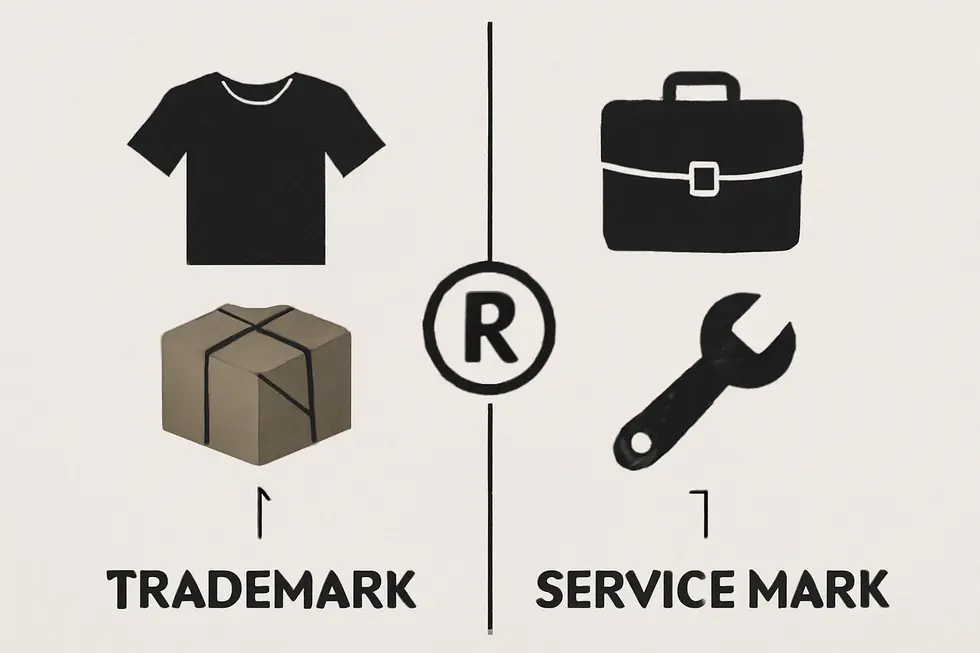Introduction
For business owners, protecting brand identity is critical to maintaining market presence and consumer trust. Recognizing the difference between a trademark and a service mark is a foundational step in securing the correct legal protections for your business offerings. While both serve to identify the origins of commercial products or services, the distinction lies in what they represent—tangible goods or intangible services. This understanding ensures you choose the right protection to safeguard your brand’s value and prevent consumer confusion. Exploring this subject through five detailed lenses—including legal frameworks, real-world examples, and strategic implications—equips entrepreneurs with the knowledge to navigate intellectual property protections confidently.
Tables of Contents
Chapter 1: Understanding the Difference Between Trademark and Servicemark: Identifying Goods Versus Services
- Clarifying the Core Distinction: How Trademarks and Service Marks Define Goods and Services
- Navigating the Legal Landscape: Registration and Protection of Trademarks and Servicemarks
- Illustrative Cases Highlighting How Trademarks and Service Marks Define Goods and Services
- Economic and Strategic Business Impact of Distinguishing Trademarks from Service Marks
- Navigating the Complexities of Distinguishing Trademarks from Service Marks in Business Identity
Chapter 2: Legal Framework Surrounding the Difference Between Trademark and Servicemark
- Clarifying Legal Definitions and Boundaries of Trademarks versus Service Marks
- Navigating the Trademark and Service Mark Registration Process Under U.S. Law
- Navigating Legal Protections and Enforcement: Securing Trademarks and Service Marks
- Decoding Usage Symbols: How ™, ℠, and ® Define Trademark and Service Mark Rights
- Navigating the Legal Overlap and Dual Use of Trademarks and Service Marks
Chapter 3: Examples Illustrating the Difference Between Trademark and Servicemark in Commercial Use
- How Legal Foundations Shape the Distinction Between Trademark and Servicemark in Commerce
- How Distinct Branding of Products and Services Shapes Market Identity
- Expanding Brand Protection: How Technological and Sensory Marks Illustrate Trademark and Servicemark Distinctions
- Strategic Brand Protection: Economic and Commercial Implications of Trademarks Versus Servicemarks
- How Consumer Recognition Reflects the Distinct Roles of Trademarks and Servicemarks
Chapter 4: Practical Implications of the Difference Between Trademark and Servicemark for Businesses
- Navigating the Scope of Protection: How Trademarks and Service Marks Safeguard Business Identities
- Streamlining Registration and Legal Strategies for Trademarks and Servicemarks
- Strategic Brand Protection and Enforcement: Navigating Trademark and Service Mark Distinctions
- How Trademark and Service Mark Distinctions Shape Business Growth and Market Expansion Strategies
- Avoiding Pitfalls: Navigating Common Misunderstandings of Trademark and Service Mark Usage
Chapter 5: Brand Protection Strategies Based on the Difference Between Trademark and Servicemark
- Fundamental Concepts and Legal Definitions Underpinning Trademark and Service Mark Strategies
- Strategic Registration and Scope: Tailoring Brand Protection to Trademarks and Service Marks
- Strategic Enforcement and Vigilant Monitoring: Safeguarding Trademarks and Servicemarks
- Navigating Legal Frameworks: Key Regulatory Insights for Trademark and Service Mark Protection
- Implementing Effective Brand Protection: Aligning Strategy with Trademark and Service Mark Distinctions
Chapter 1: Understanding the Difference Between Trademark and Servicemark: Identifying Goods Versus Services

1. Clarifying the Core Distinction: How Trademarks and Service Marks Define Goods and Services
Trademarks and service marks both serve the crucial role of identifying the source of a company’s offerings, but they differ primarily in what they signify. A trademark distinguishes goods—tangible physical products like apparel or packaged items—by marking them with specific words, logos, or symbols. Conversely, a service mark identifies intangible services such as dining experiences, legal advice, or financial consulting. Although they operate within the same legal framework and are often protected by the same registration process through entities like the USPTO, the nature of what they protect remains distinct.
This distinction guides businesses in safeguarding their brands appropriately, ensuring consumers can reliably distinguish the origin of goods or services. For instance, a logo on a product package functions as a trademark, whereas the same logo used to promote a related service is considered a service mark. Both marks grant exclusive rights upon registration, preventing unwarranted use by others and maintaining clear market identity. For deeper insights on brand protection and related topics, see trademark protection for business names and logos.
Additional official guidance can be found through the USPTO’s service mark registration resources.
2. Navigating the Legal Landscape: Registration and Protection of Trademarks and Servicemarks
The legal framework governing trademarks and service marks functions under a unified system, primarily managed by the USPTO. While the core registration process is identical, the key distinction involves what the mark protects: trademarks apply to tangible goods, whereas service marks represent intangible services. Both marks can include words, logos, slogans, or other identifying symbols. Registration grants exclusive nationwide rights, constructive public notice, and protection against infringement in federal courts.
To register, applicants specify whether the mark covers products or services, with active or intended commercial use as prerequisites. Marks remain valid for ten years and are renewable indefinitely if still in use. Many businesses maintain both types simultaneously, covering products with trademarks and services with service marks. This integrated legal system optimizes brand protection by clearly identifying the source of goods or services, minimizing consumer confusion and safeguarding commercial identity.
For in-depth registration guidance, see service mark registration at UpCounsel. For further reading on brand protection strategies, explore trademark protection for business names and logos.
3. Illustrative Cases Highlighting How Trademarks and Service Marks Define Goods and Services
Illustrative Cases Highlighting How Trademarks and Service Marks Define Goods and Services
Trademarks and service marks serve as essential identifiers in commerce, distinguishing the origin of goods and services respectively. For instance, a symbol placed on a physical product clearly signals a trademark. Conversely, a company’s name or slogan representing its provision of services functions as a service mark. This distinction is key when a business offers both tangible products and intangible services; each aspect requires appropriate protection. Some brands use trademarks on their merchandise, while simultaneously employing service marks for their associated service offerings. Even unique sounds can qualify—for example, an audio logo used in broadcasting often registers as a service mark since it identifies a service rather than a product. Legal protections for both marks arise under the same statutes, yet understanding these nuanced examples guides businesses in securing the correct form of brand identity. For a deeper dive into trademark specifics, explore more on trademark protection for business names and logos. Further details on service mark examples are available through UpCounsel’s resources[1].
4. Economic and Strategic Business Impact of Distinguishing Trademarks from Service Marks
The economic impact of distinguishing between a trademark and a service mark is critical for business success. Trademarks protect the branding of tangible goods, while service marks safeguard the identity of service-based offerings. This distinction affects legal protection, ensuring businesses secure the right type of registration through the USPTO to enforce exclusive rights effectively. Marketing strategies also hinge on this clarity, as consumers rely on these marks to differentiate products from services, reducing confusion and enhancing brand loyalty. Moreover, proper mark registration bolsters a company’s market value and competitive advantage, becoming a vital intangible asset that attracts investment and supports business growth. Additionally, a well-protected brand increases business creditworthiness, opening doors to financing and partnerships. For deeper insights on trademark protection in business, refer to trademark protection for business name and logo. Further legal guidance is detailed at Service Mark Registration – UpCounsel.
5. Navigating the Complexities of Distinguishing Trademarks from Service Marks in Business Identity
A key difficulty in distinguishing a trademark from a service mark lies in correctly identifying whether the mark applies to goods or services. Both function similarly to signify the source of a business, yet one protects tangible products like apparel or electronics, while the other protects intangible offerings such as legal or restaurant services. This conceptual overlap means marks often look visually alike—words, logos, or slogans—causing confusion over classification. Properly categorizing a mark when registering with the USPTO is crucial, especially as many businesses provide both products and services or blur this line, like software sold as a product versus delivered as a service. Legal enforcement poses further challenges; proving service mark infringement is inherently harder due to the intangible nature of services. Moreover, consumer perception differs: physical goods bear marks clearly on products, whereas service marks rely on consumers associating the mark with their experience, which is more subjective. Carefully analyzing offerings ensures correct identification, essential to secure the appropriate protection and strengthen brand identity. For practical guidance on classification and registration, useful insights are available through detailed service mark registration guides.
Chapter 2: Legal Framework Surrounding the Difference Between Trademark and Servicemark

1. Clarifying Legal Definitions and Boundaries of Trademarks versus Service Marks
Clarifying Legal Definitions and Boundaries of Trademarks versus Service Marks
Within the legal realm, trademarks and service marks serve to uniquely identify the origin of commercial offerings but differ fundamentally in scope. A trademark legally protects distinctive words, symbols, or combinations that identify tangible products sold by a business, such as clothing or electronics. Conversely, a service mark applies the same legal protection to intangible services like consulting, dining, or financial advising. Both marks are registered under the same legal framework, typically through the USPTO, ensuring exclusive rights nationwide once registration requirements—such as proof of use and distinctiveness—are met. These protections help prevent consumer confusion and safeguard brand reputation by clearly denoting the source of goods or services. Businesses offering both products and services may hold both marks to comprehensively protect their brand identity. For a deeper exploration of these protections, see resources on service mark registration from UpCounsel.
2. Navigating the Trademark and Service Mark Registration Process Under U.S. Law
The registration process for trademarks and service marks within the legal framework is virtually identical, with the distinction rooted solely in whether the mark identifies goods (trademark) or services (service mark). Applicants begin by conducting a clearance search to ensure the mark is distinctive and unregistered. Next, they submit an application through the USPTO’s Trademark Electronic Application System (TEAS), detailing a clear image of the mark, specifying the associated goods or services, and noting the first commercial use date. A USPTO attorney then examines the application for compliance and potential conflicts, sometimes issuing an Office Action requiring a response. If passed, the mark is published in the Official Gazette, allowing others to oppose within 30 days. Absent opposition, registration grants nationwide protection for ten years, renewable indefinitely with proof of continuous use. While federal registration is optional, it strengthens legal rights, including presumptive ownership and federal court enforcement. This equivalency in registration underscores how trademarks and service marks are unified under U.S. law, distinguished only by the nature of the commercial offering. For businesses seeking detailed guidance, exploring trademark protection for brand names and logos can offer valuable insights. For additional in-depth legal perspectives on registration, consult UpCounsel’s service mark registration article.
3. Navigating Legal Protections and Enforcement: Securing Trademarks and Service Marks
The legal protections for trademarks and service marks share a unified framework through the United States Patent and Trademark Office (USPTO). Both grant exclusive nationwide rights to prevent others from using confusingly similar marks on goods or services, preserving brand identity and consumer trust. While trademarks apply to tangible products, and service marks to intangible services, their registration processes and enforcement mechanisms are nearly identical. Rights arise from use in commerce, but federal registration provides added benefits including constructive notice, nationwide rights, federal lawsuit eligibility, and a foundation for international protection. Enforcement involves proving ownership and likelihood of confusion, with common defenses like fair use or abandonment. Maintaining these rights requires distinctiveness, proper use, and timely renewals. This cohesive legal system ensures that whether protecting a product logo or service brand, businesses receive consistent remedies against infringement, safeguarding their market presence. For further details, see USPTO resources and expert guidance such as UpCounsel’s articles on service mark registration. Learn more about trademark protection for business names and logos.
4. Decoding Usage Symbols: How ™, ℠, and ® Define Trademark and Service Mark Rights
Usage symbols play a pivotal role in clarifying the legal status and scope of trademarks and service marks. The ™ symbol signals an unregistered claim on a trademark related to goods, alerting the public to brand ownership without requiring formal registration. Similarly, ℠ functions like ™ but specifically denotes service marks, applying to intangible service branding like business names or slogans. In contrast, the ® symbol is reserved exclusively for marks officially registered with the United States Patent and Trademark Office (USPTO), representing a stronger legal claim and allowing enforcement actions such as infringement lawsuits. While ™ and ℠ serve as notices of claimed rights, they do not guarantee protection, making registration—and the authorized use of ®—essential for robust legal defense. Misusing ® without registration can result in legal penalties. Together, these symbols underpin the legal framework distinguishing trademarks from service marks by clearly communicating the nature of the mark and its registration status, thus preventing consumer confusion and guiding enforcement. For more on the registration process and implications, consult UpCounsel’s detailed guide on service mark registration.
5. Navigating the Legal Overlap and Dual Use of Trademarks and Service Marks
The legal distinction between trademarks and service marks centers on the types of commercial offerings they protect—products or services—but their legal frameworks substantially overlap. Both are governed under the same registration and enforcement systems, such as those administered by the USPTO, with similar requirements for proof of use and maintenance. This overlap frequently leads businesses offering both products and services to hold dual registrations, safeguarding distinct aspects of their brand identity. For instance, a business can register a trademark for its tangible goods and a service mark for related services, both enjoying equal legal protection and renewal terms. Symbols such as ™ and SM mark unregistered trademarks and service marks respectively, while ® denotes registration for either. This unified approach simplifies brand protection across different commercial activities, reflecting the practical reality that many enterprises operate in blended goods-services markets. Legal agreements equally recognize both marks, restricting unauthorized use to preserve brand goodwill. For more detailed guidance on registration, see service mark registration and explore strategies for strong brand defense at Trademark2Go’s trademark protection insights.
Chapter 3: Examples Illustrating the Difference Between Trademark and Servicemark in Commercial Use

1. How Legal Foundations Shape the Distinction Between Trademark and Servicemark in Commerce
Both trademarks and servicemarks serve the critical function of identifying the source of commercial offerings, but they differ fundamentally in their scope. Trademarks specifically protect tangible goods—products that consumers can physically possess—while servicemarks identify intangible services such as broadcasting, consulting, or hospitality. This distinction is enshrined in the Lanham Act, the key U.S. statute governing registration and protection of both types of marks. The United States Patent and Trademark Office (USPTO) handles the registration process, allowing businesses to secure exclusive rights symbolized by ® and the designations TM or SM for unregistered marks. Examples clarify the difference: a product’s unique packaging or logo is a trademark, whereas a distinct sound or logo used to promote services is a servicemark. Understanding these legal foundations is vital for businesses to choose appropriate protection strategies tailored to whether they market goods or services. For further insights, explore detailed guidance on trademark protection for business names and logos. More information is available through the Lanham Act and USPTO resources.
2. How Distinct Branding of Products and Services Shapes Market Identity
The core distinction between trademarks and service marks lies in their role in commercial branding: trademarks identify tangible products, while service marks apply exclusively to intangible offerings. A trademark might protect the unique look or color associated with physical items, reinforcing consumer trust in product quality and origin. In contrast, service marks safeguard the branding tied to intangible services like consulting, hospitality, or legal assistance, helping customers recognize the service provider’s reputation.
This differentiation affects how businesses protect their brand identity and engage consumers. For example, a company that offers both products and services often registers both marks to cover each market facet. This dual approach enhances brand clarity and market presence by clearly signaling the source of goods versus services. Despite this, both marks receive comparable legal protection and registration treatment under trademark law.
For businesses aiming for comprehensive brand protection, understanding these distinctions is vital. It ensures appropriate registration and enforcement strategies that respect the unique nature of goods and services. Further details on these strategic uses can be explored in the trademark protection for business name or logo resource. Additional insights are available at UpCounsel for those seeking detailed legal perspectives on service mark registration.
3. Expanding Brand Protection: How Technological and Sensory Marks Illustrate Trademark and Servicemark Distinctions
The distinction between trademarks and service marks extends into advanced branding tools such as technological and sensory marks. While traditional trademarks identify tangible goods—like distinctive shapes or colors—and service marks denote brands offering intangible services, emerging mark types highlight new dimensions. Technological marks cover dynamic, digital elements such as unique sounds or motion-based features associated with a product or service. For example, a digital startup sound can serve as a trademark for goods or a service mark if tied to a service brand. Sensory marks encompass non-visual indicators like brand-specific scents or signature sounds that uniquely signal product or service origins to consumers. These marks must clearly identify and distinguish the source of offerings, whether goods or services, reinforcing brand identity in novel ways. Understanding these advanced marks is vital for protecting innovative branding strategies under trademark law and ensuring businesses select the appropriate protection for their commercial assets. For deeper insights on effectively securing brand identifiers, consider exploring trademark protection of business names and logos. Further context on these distinctions is available through legal analyses such as those found on UpCounsel service mark registration.
4. Strategic Brand Protection: Economic and Commercial Implications of Trademarks Versus Servicemarks
Trademarks and servicemarks serve distinct, yet equally pivotal roles in protecting business identity. Trademarks safeguard tangible products by distinguishing goods in competitive marketplaces, often translating into enhanced brand equity and the ability to command premium pricing. Signature shapes, colors, and logos linked to a physical product become valuable assets communicating quality and origin. Conversely, servicemarks protect intangible offerings, where reputation and trust are paramount. By securing a servicemark, businesses prevent consumer confusion in industries reliant on service quality, directly preserving revenue and market presence.
For businesses, recognizing whether their brand primarily represents goods or services is critical. This determines the precise legal protection they pursue and influences licensing strategies—for example, licensing a trademark entails rights to product manufacturing, whereas a servicemark license grants service provision rights. Firms offering both may register marks in both categories to comprehensively shield their brand. Sustained commercial use is essential in maintaining these rights, making strategic brand management essential to ongoing economic success.
For more insights on trademark protection and strategy, visit trademark protection for business names and logos. The U.S. Patent and Trademark Office offers detailed guidance on these distinctions and protections[1].
5. How Consumer Recognition Reflects the Distinct Roles of Trademarks and Servicemarks
Trademarks and servicemarks distinctly guide consumer recognition by indicating the source of goods versus services. While a trademark visually signals the origin and quality of physical products through logos, packaging, or unique features, a servicemark identifies a service provider’s reputation and expected experience. For instance, consumers associate trademarks with characteristics such as product consistency or brand loyalty. Conversely, servicemarks build trust in service quality and provider reliability, helping consumers differentiate among competing service providers. Although legal protections for both overlap and are often managed under trademark law, the marketplace perception diverges: trademarks focus on tangible product identity, while servicemarks emphasize the intangible service relationship. This differentiation helps prevent confusion in commerce and reinforces brand integrity across both product and service sectors. For further insights on protecting your brand identity effectively, see trademark protection for business name and logo. Detailed legal perspectives on service mark registration are available through external resources such as UpCounsel.
Chapter 4: Practical Implications of the Difference Between Trademark and Servicemark for Businesses

1. Navigating the Scope of Protection: How Trademarks and Service Marks Safeguard Business Identities
The scope of protection for trademarks and service marks is legally similar but tailored to different commercial realities. Trademarks secure exclusive rights over tangible products, while service marks do the same for intangible services. This dual framework allows businesses to safeguard brand identity across diverse offerings, from physical goods to consulting or financial services. Registration through the USPTO grants nationwide exclusive use rights and constructive notice to the public, strengthening enforcement against infringement. Companies engaged in both product sales and service provision often need to register both marks to fully protect their brand assets. These marks also contribute significant intangible value, enhancing market presence, customer loyalty, and business growth, including international expansion under systems like the Madrid Protocol. However, protection includes inherent limitations such as geographic reach and legal defenses like fair use. Understanding these boundaries is crucial to maintain robust brand safeguards and avoid pitfalls in registration or enforcement. For businesses interested in comprehensive protection of brand elements, this nuanced scope plays a central role in strategic intellectual property management. For further insights on trademark protection related to brand names and logos, see trademark2go.com/trademark-protection-business-name-logo. Additionally, the USPTO provides detailed guidelines on registration and enforcement to support effective mark protection.
2. Streamlining Registration and Legal Strategies for Trademarks and Servicemarks
The registration process for trademarks and servicemarks, administered by the USPTO under the Lanham Act, is fundamentally similar but requires precise classification based on the business asset—products or services. Businesses must first determine whether their mark will represent tangible goods or intangible services to select the correct category. Applications are submitted online through the USPTO’s TEAS system, specifying the mark type, format, and detailed description of goods or services. The USPTO then reviews the submission for distinctiveness, compliance, and to avoid conflicts with existing marks. Legal considerations center on the mark’s distinctiveness and the likelihood of confusion with others, ensuring the brand remains unique and protectable. Both trademark and servicemark registrations confer exclusive rights for ten years, with renewal contingent on continued use. For businesses operating internationally, treaties like the Madrid Protocol offer avenues for global protection, though attention to jurisdictional nuances remains essential. This strategic registration approach enables businesses to safeguard their identity effectively and prevents infringement disputes. For comprehensive procedural guidance, resources such as Service Mark Registration – UpCounsel offer valuable insights. Additionally, understanding trademark essentials can be enhanced by exploring trademark protection for business names and logos.
3. Strategic Brand Protection and Enforcement: Navigating Trademark and Service Mark Distinctions
The distinction between trademarks and service marks plays a crucial role in shaping a business’s brand strategy and enforcement approach. Businesses must first determine whether their offerings fall under goods or services, as this decision informs whether to register trademarks or service marks. Trademarks protect identifiers tied to physical products, reinforcing consumer trust in product quality and origin. In contrast, service marks safeguard intangible service brands, assuring customers of reliable service experiences. Many companies adopt a dual approach, securing both types of marks to cover diverse market activities, which demands cohesive brand management. Enforcement of these marks hinges on preventing confusingly similar use within relevant categories, with legal remedies available to uphold exclusivity and protect market reputation. Monitoring related goods or services is essential, as overlapping markets may trigger infringement concerns despite different classifications. For startups, securing the correct mark promptly is vital to strengthening market presence and legal protection. Moreover, expanding businesses must consider registering marks internationally to maintain brand consistency. Digital brand protection also relies on understanding these distinctions to effectively guard domain names and online identities. For deeper insight into service mark registration, consult this resource. For detailed guidance on protecting your brand name and logo, see trademark protection business name & logo.
4. How Trademark and Service Mark Distinctions Shape Business Growth and Market Expansion Strategies
Understanding the distinction between trademarks and service marks profoundly shapes how businesses strategize growth and enter new markets. A trademark secures the identity of tangible products, while a service mark protects intangible service offerings. This clarity allows companies to align their intellectual property registration specifically with their core activities, enhancing legal protection and consumer trust. When expanding into competitive or international markets, proper registration prevents infringement and conveys exclusivity, which is vital for maintaining brand reputation. Businesses offering both goods and services benefit from managing dual protections, ensuring their entire brand ecosystem is secured. This strategic approach not only supports clear market positioning but also optimizes legal enforcement and brand recognition, fueling smoother entry and sustainable growth. For a deeper guide on service mark registration, consult trusted legal resources like UpCounsel.
5. Avoiding Pitfalls: Navigating Common Misunderstandings of Trademark and Service Mark Usage
Understanding the difference between trademarks and service marks is crucial, yet businesses often confuse their scope and usage, leading to costly errors. Trademarks protect identifiers of tangible goods, while service marks apply to intangible services, but these distinctions are frequently overlooked. Misapplication of symbols—™ for goods, ℠ for services before registration, and ® only after federal registration—is a widespread mistake that can undermine legal claims. Businesses may also err by registering the incorrect type of mark or neglecting comprehensive clearance searches, increasing risks of infringement disputes. Furthermore, companies offering both products and services may fail to secure protection for both categories, weakening their brand defense. Digital branding further complicates matters, as online services blur traditional lines. Proactive monitoring and enforcement are essential to maintain mark rights and prevent abandonment. For deeper guidance on trademark and service mark practices, see this detailed resource on trademark protection for business names and logos. External expertise such as UpCounsel’s articles on service mark registration provide valuable insights to avoid these challenges.
Chapter 5: Brand Protection Strategies Based on the Difference Between Trademark and Servicemark

1. Fundamental Concepts and Legal Definitions Underpinning Trademark and Service Mark Strategies
Fundamental Concepts and Legal Definitions Underpinning Trademark and Service Mark Strategies
A trademark and a service mark both serve as critical identifiers that protect a brand’s identity, but they diverge in what they represent within the marketplace. A trademark uniquely identifies tangible goods such as clothing or electronics, while a service mark applies to intangible services like legal consulting or restaurant operations. Despite this distinction, they often share overlapping features such as logos, slogans, or even sounds, all of which signal the origin of a business’s offerings.
Legally, both marks are registered with the same authority, typically the United States Patent and Trademark Office (USPTO), following similar procedures requiring use or intent to use. Proper classification during registration is essential; misidentifying goods as services or vice versa can undermine legal protections. By recognizing these foundational differences, businesses can craft effective strategies to secure and maintain exclusive rights, encouraging brand loyalty and reducing consumer confusion.
For detailed legal advice on securing these protections, businesses can refer to resources like UpCounsel’s service mark registration overview and explore trademark fundamentals at Trademark2Go’s trademark protection guide.
2. Strategic Registration and Scope: Tailoring Brand Protection to Trademarks and Service Marks
Strategic Registration and Scope: Tailoring Brand Protection to Trademarks and Service Marks
Effective brand protection hinges on recognizing that trademarks cover goods while service marks cover services. Precise registration is critical—applying for the correct mark type ensures legal safeguards align with your business offerings. Companies offering both products and services should secure protection for each via respective registrations to prevent gaps in enforcement. Crafting distinctive logos, names, or slogans that clearly identify either goods or services strengthens brand exclusivity and reduces consumer confusion. Vigilant monitoring for unauthorized use and diligent maintenance through timely renewals uphold these rights over time. This focused approach to the distinctive scope and registration optimizes a brand’s legal resilience and marketplace clarity. For more on securing service mark protection, consult detailed guidelines on service mark registration and relevant strategies from resources like trademark protection for business names and logos.
3. Strategic Enforcement and Vigilant Monitoring: Safeguarding Trademarks and Servicemarks
Strategic Enforcement and Vigilant Monitoring are essential components in protecting trademarks and servicemarks, though each presents unique challenges. Trademarks secure goods-related identifiers, making infringement typically easier to detect through physical product analysis or counterfeit sales monitoring. Servicemarks, however, protect intangible services, complicating evidence gathering and proof of consumer confusion. Both require proactive, continuous surveillance of digital and offline channels—including official databases, online marketplaces, and social media. Employing AI-driven tools helps identify unauthorized use, counterfeit domains, and imitation accounts swiftly. Once detected, enforcement measures such as cease-and-desist letters and litigation maintain the mark’s legal strength and prevent dilution. Uniform, consistent action is especially critical for servicemarks due to their intangibility. Integrating monitoring with broader strategies like policy enforcement and market intelligence ensures robust protection. This comprehensive approach preserves brand integrity and legal rights, tailored to the nature of goods or services offered. For deeper insight on practical monitoring tactics, explore trademark protection strategies for business names and logos. External guidance from resources like Huntsville Estate Planning Lawyers offers valuable legal perspectives on maintaining enforcement rigor.
4. Navigating Legal Frameworks: Key Regulatory Insights for Trademark and Service Mark Protection
Understanding the legal and regulatory framework underlying trademarks and service marks is essential for effective brand protection. Both marks are registered and enforced under the same system, typically through the United States Patent and Trademark Office (USPTO), granting exclusive nationwide rights to use the mark in commerce. This registration provides constructive notice to the public and enables federal court enforcement, including injunctions and damages for infringement. While trademarks identify tangible goods and service marks safeguard intangible service offerings, they share identical registration procedures and legal remedies.
Protecting a brand fully may require securing both marks when a business offers goods and services. Maintaining rights involves ongoing responsibilities such as proving use, meeting renewal deadlines, and managing licensing carefully to avoid jeopardizing the mark. Additionally, federal registration facilitates customs enforcement against counterfeit goods and supports global protection through international treaties. These considerations emphasize that recognizing the nuances between trademarks and service marks strengthens legal defenses, prevents consumer confusion, and preserves brand value over time. For further details on registration and legal protections, refer to resources like the USPTO and authoritative legal guides such as UpCounsel.
For a deeper understanding, explore trademark protection of business names and logos. External resource: USPTO Trademark and Service Mark Registration.
5. Implementing Effective Brand Protection: Aligning Strategy with Trademark and Service Mark Distinctions
Successful brand protection begins with recognizing whether a business offers goods or services, as this determines whether to secure a trademark or service mark. Trademarks safeguard the unique identifiers—names, logos, slogans—used on physical products, while service marks protect similar identifiers related to intangible services. Registering the appropriate mark not only grants constructive notice and strengthens enforcement but also facilitates global expansion through treaties like the Madrid Protocol. Using ™ for trademarks and ℠ for service marks clearly signals proprietary claims even before registration. Vigilant monitoring and prompt action against infringement prevent brand dilution, ensuring market trust remains intact. Moreover, licensing with strict quality controls preserves brand reputation across both products and services. Lastly, treating marks as valuable intellectual property enables businesses to strategically assign or license them, unlocking growth and enhancing brand equity. These integrated strategies produce robust legal protection and lasting consumer recognition. For more information on trademark registration, visit Trademark2Go. For detailed legal guidance on service mark registration, consult resources like UpCounsel.
Final thoughts
Understanding the difference between a trademark and a service mark is vital for any business aiming to protect its brand identity accurately and effectively. By distinguishing whether your offerings comprise tangible goods or intangible services, you can apply for the correct type of mark and secure your legal rights under the appropriate frameworks. This clarity not only prevents consumer confusion but also strengthens your competitive edge in the marketplace. Equipped with examples, legal knowledge, and practical strategies, business owners can confidently implement protections that safeguard their unique market position and foster long-term brand loyalty.
Your IP is the foundation of your success – let’s protect it together before it’s too late. We can’t wait to help you turn your ideas into legally secured assets.
About us
undefined



Your point of view caught my eye and was very interesting. Thanks. I have a question for you.